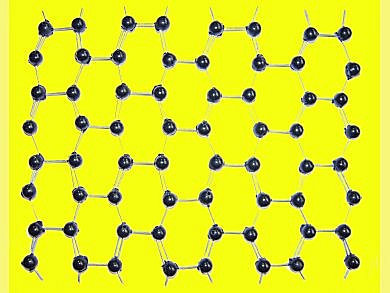Molecular models typically are constructed by attaching one atom after the other to each other. H.-J. Quadbeck-Seeger has realized a paradigm shift in this concept. In his MoletomicsTM System the skeleton of the molecule is first bent out of wire. The atoms are then attached to this.
Quadratic wire lattices and plastic pellets proved particularly suitable for this purpose. This way, nearly all carbon molecules can be made simply and at low costs. This is also true for the three forms of elemental carbon. Besides C60 and the lattice of diamantes, this is especially true for the now famous graphene.
The stable and aesthetic model also accurately depicts the electronic configuration of one of the many possible forms. The enlargement factor is 1:109.

- Modelle für C60-Fulleren,
H.-J. Quadbeck-Seeger,
Chem. Unserer Zeit 2010, 44 (3), 230–231.
DOI: 10.1002/ciuz.201090042 - www.Quadbeck-Seeger.de/bilder/moletomics
- Ein neuartiges Konzept zum Bau von Molekül-Modellen,
H.-J. Quadbeck-Seeger,
Chem. Unserer Zeit 2010, 44, 154–157.
DOI: 10.1002/ciuz.201090018 - Modelle für Graphen – einfach und dennoch eindrucksvoll,
H.-J. Quadbeck-Seeger,
Phys. Unserer Zeit 2011, 42, 46.
DOI: 10.1002/piuz.201090096 - Das Diamant-Gitter, Kristallstrukturen und Molekül-Modelle,
H.-J. Quadbeck-Seeger,
Chem. Unserer Zeit 2011, 45, 60–63.
DOI: 10.1002/ciuz.201190009 - Nanoröhren-Modelle,
H. J. Quadbeck-Seeger
Chem. Unserer Zeit 2011, 45, 139–143.
DOI: 10.1002/ciuz.201190020




